|
|
|
Sort Order |
|
|
|
Items / Page
|
|
|
|
|
|
|
| Srl | Item |
| 1 |
ID:
128265
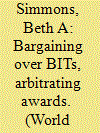

|
|
|
|
|
| Publication |
2014.
|
| Summary/Abstract |
The regime for international investment is extraordinary in public international law and controversial in many regions of the world. This article explores two aspects of this set of rules: its decentralization and the unusual powers it gives to private actors to invoke dispute settlement. Decentralization has contributed to a competitive environment for ratification of bilateral investment treaties (BITs) and has elevated the importance of dyadic bargaining power in the formation of the regime. Governments of developing countries are more likely to enter into BITs and tie their hands more tightly when they are in a weak bargaining position, which in turn is associated with economic downturns of the domestic economy. Once committed, investors have sued governments with surprising regularity, arguably contributing disproportionately to legal awards that favor the private corporate actors who have the power to convene the dispute settlement system. States have begun to push back, revising their obligations and attempting to annul arbitral awards. One of the conclusions is that it is important not only to consider whether BITs attract capital-which has been the focus of nearly all the empirical research on BIT effects-but also to investigate the governance consequences of the international investment regime generally.
|
|
|
|
|
|
|
|
|
|
|
|
|
|
|
|
| 2 |
ID:
129416
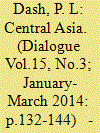

|
|
|
|
|
| Publication |
2014.
|
| Summary/Abstract |
In 2011-2012 all Central Asian countries have celebrated 20th year of their independence. They have achieved commendable progress in all spheres of their life during these years. Getting over from the monolithic ideology of communism, they have shifted to something that is not similar to any system. However, three areas are clearly discernible in the transition process of the last two decades: economy, society and ideology. The economy is no longer the command socialist economy. It is opening up, in some areas rapidly and in others slowly. Predominant private economic activities are visible in the market places. In laying the foundation of modern industry they are less visible. Foreign Direct Investment has been steadily flowing with varying degree of success in each country depending how investment savvy the FDI rules have been. The State has retained control over all spheres of economic activities. The society is no longer the communist one with free education and kindergarten, full employment guarantee to all, free housing, free medical care and many other benefits. All these have vanished. Everyone has to
fend for himself and his family. This is where it has created a schism between the haves and the have-nots thereby polarizing the society into rich and the poor. In the ideological realm, the Marxist-Leninist ideology has been completely given up. Even in academic libraries it is hard to find the works of Marx and Lenin that once adorned the shelves. Instead, works of incumbent presidents occupy the stacks. There is an irony: what the people wish to preserve, the presidents do not desire to protect.
|
|
|
|
|
|
|
|
|
|
|
|
|
|
|
|
| 3 |
ID:
125370
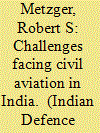

|
|
|
|
|
| Publication |
2013.
|
| Summary/Abstract |
Civil aviation in India may be taken as a study in contrasts. Despite extraordinary growth in traffic, most of India's airlines are in a precarious condition. Despite forecasts that India will add more than a thousand transport aircraft to civil fleets in the two next decades, India has too few airports and today lacks the aviation safety infrastructure required to handle the growth.
|
|
|
|
|
|
|
|
|
|
|
|
|
|
|
|
| 4 |
ID:
129642
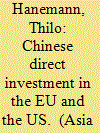

|
|
|
|
|
| Publication |
2014.
|
| Summary/Abstract |
Chinese outward foreign direct investment (OFDI) in developed economies has increased substantially in recent years, driven by policy liberalization and structural adjustments in China's economy. Efforts to accurately describe the dimensions of this increase are complicated by problems with official statistics and the complexity of deal structures. This article introduces the major problems of capturing data on global cross-border investment flows and elaborates on the particular difficulties of measuring Chinese outward FDI. It identifies alternative datasets that can help to better capture the scope and patterns of the Chinese overseas investment and uses one of them to describe the growth of Chinese investment in the EU and the US since 2000, highlighting similarities and differences in investment patterns in the world's two biggest economies.
|
|
|
|
|
|
|
|
|
|
|
|
|
|
|
|
| 5 |
ID:
124564


|
|
|
|
|
| Publication |
2013.
|
| Summary/Abstract |
We empirically analyze the host-country determinants of Chinese outward direct investments (ODI) in the period from 2003 to 2008, using disaggregated data by country and sector and distinguishing between state-owned or controlled enterprises (SOEs) and privately-owned firms. Our results show that the pattern of Chinese ODI differs according to corporate ownership. Private firms are attracted by large markets and host-country strategic assets and are averse to economic and political risks when choosing investment locations abroad. Differently, state-owned or controlled enterprises follow the strategic needs of their home country and invest more in natural resource sectors, being largely indifferent to the political and economic conditions in the host countries.
|
|
|
|
|
|
|
|
|
|
|
|
|
|
|
|
| 6 |
ID:
132519
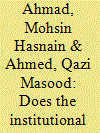

|
|
|
|
|
| Publication |
2014.
|
| Summary/Abstract |
This study investigates the role of the institutions as a determinant of foreign direct investment (FDI) in the case of Pakistan by applying the autoregressive distributed lag (ARDL) cointegration technique. The results demonstrate that the institutional quality exerts long-run impact in determining the FDI inflows. The findings suggest that institutional quality is an important determinant of the FDI in Pakistan. The joint impact of institutional quality and trade openness is also significant and positively contribute to attract FDI in the short run as well as in the long run. The findings strongly support the hypothesis that simultaneous implementation of policy mix, that is, reducing trade barriers and improvement in institutional quality, play significant role in attracting FDI in a developing country like Pakistan.
|
|
|
|
|
|
|
|
|
|
|
|
|
|
|
|
| 7 |
ID:
125014
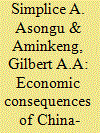

|
|
|
|
|
| Publication |
2013.
|
| Summary/Abstract |
This study dissects with great acuteness some of the big questions on China-Africa relations in order to debunk burgeoning myths surrounding the nexus. It reviews a wealth of recent literature and presents the debate in three schools of thought. No substantial empirical evidence is found to back up sinister prophesies of coming catastrophe from critics of the direction of China-Africa relations. In the mean, the relationship from an economic standpoint is promising and encouraging but more needs to be done regarding multilateral relations, improvement of institutions, and sustainability of resources management. A number of positive signs suggest that China is heading toward the direction which would provide openings for a multipolar dialog. While benefiting in the short run, African governments have the capacity to tailor this relationship and address some socio-economic matters arising that may negatively affect the nexus in the long term. Policy implications are discussed.
|
|
|
|
|
|
|
|
|
|
|
|
|
|
|
|
| 8 |
ID:
132521
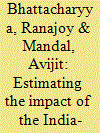

|
|
|
|
|
| Publication |
2014.
|
| Summary/Abstract |
This study shows that intermediate goods will be more affected (both adversely and favourably) than final goods due to ASEAN-India FTA. Other interesting conclusions include tariffs do not matter at all for a major part of the industries and for them the agreement has no significance. In fact, some of the most debated commodities fall in this category. For them though tariff rates have steadily increased over time, so has imports imparting a wrong sign to the tariff elasticity which means that reasons other than tariffs determine their imports and there is no point in putting them in the sensitive or exclusion list.
|
|
|
|
|
|
|
|
|
|
|
|
|
|
|
|
| 9 |
ID:
128266


|
|
|
|
|
| Publication |
2014.
|
| Summary/Abstract |
Although many features of bilateral investment treaties (BITs) are consistent from one agreement to the next, a closer look reveals that the treaties exhibit considerable variation in terms of their enforcement provisions, which legal scholars have singled out as the central component of the treaties. An original data set is compiled that captures three important treaty-design differences: whether the parties consent in advance to international arbitration, whether they allow treaty obligations to be enforced before an institutionalized arbitration body, and how many arbitration options are specified for enforcement. Drawing upon several relevant literatures on international institutions, three potentially generalizable explanations for this important treaty variation are articulated and tested. The strongest support is found for the theoretical perspective that emphasizes the bargaining power and preferences of capital-exporting states, which use the treaties to codify strong, credible investor protections in all their treaties. Empirical tests consistently reveal that treaties contain strong enforcement provisions-in which the parties preconsent to multiple, often institutionalized arbitration options-when the capital-exporting treaty partner has considerable bargaining power and contains domestic actors that prefer such arrangements, such as large multinational corporations or right-wing governments. In contrast, there is no evidence to support the popular hands-tying explanation, which predicts that investment-seeking states with the most severe credibility problems, due to poor reputations or weak domestic institutions, will bind themselves to treaties with stronger investment protections. likewise, little support is found for explanations derived from the project on the rational design of international institutions, which discounts the identities and preferences of the treaty partners and instead emphasizes the structural conditions they jointly face. In sum, this foundational study of differences across investment treaties suggests that the design of treaties is driven by powerful states, which include elements in the treaties that serve their interests, regardless of the treaty partner or the current strategic setting.
|
|
|
|
|
|
|
|
|
|
|
|
|
|
|
|
| 10 |
ID:
129644


|
|
|
|
|
| Publication |
2014.
|
| Summary/Abstract |
This article explores the political challenges posed by the recent influx of Chinese outward foreign direct investment (OFDI) into the European Union (EU), which has become in 2011 the top destination for Chinese investment in the world. The central political question facing European states welcoming the influx of Chinese capital is whether this is a good bargain-a positive-sum game where both investor and investee benefit-or instead a Faustian bargain-a zero-sum game in the long term where capital is accompanied by implicit conditionality affecting European norms and policies, from human rights to labor laws. The novelty of Chinese FDI has the potential to affect politics in Europe in three different venues: inside European countries, between European countries, and between Europe and third countries. This article, whose main goal is to launch a research agenda on the political implications of Chinese FDI, explores in turn its potential impact on foreign and domestic policy, institutional process within the EU, and transatlantic relations
|
|
|
|
|
|
|
|
|
|
|
|
|
|
|
|
| 11 |
ID:
137967


|
|
|
|
|
| Publication |
New Delhi, Orient Blackswan, 2015.
|
| Description |
xix, 298p.Hbk
|
| Standard Number |
9788125057741
|
|
|
|
|
|
|
|
|
|
|
|
Copies: C:1/I:0,R:0,Q:0
Circulation
| Accession# | Call# | Current Location | Status | Policy | Location |
| 058196 | 332.6730954/PAN 058196 | Main | On Shelf | General | |
|
|
|
|
| 12 |
ID:
132570


|
|
|
|
|
| Publication |
2014.
|
| Summary/Abstract |
After decades of isolation, Myanmar is now actively re-engaging with the global economy. For successful re-engagement, Myanmar needs to implement comprehensive economic reforms based on a shared vision of long-term economic development characterized by human-centred, sustainable, pro-poor, inclusive, high and balanced economic growth. In this paper, we propose five growth strategies: an "Agriculture Plus Plus" strategy; an export-oriented strategy; a foreign direct investment driven strategy; a two-polar growth strategy; and a domestic economic corridors development strategy. These strategies are used as guides to translate wide-ranging development agendas into a set of implementable policies, programmes, and projects.
|
|
|
|
|
|
|
|
|
|
|
|
|
|
|
|
| 13 |
ID:
128982
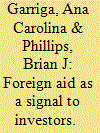

|
|
|
|
|
| Publication |
2014.
|
| Summary/Abstract |
Does development aid attract foreign direct investment (FDI) in post-conflict countries? This article contributes to the growing literature on effects of aid and on determinants of FDI by explaining how development aid in low-information environments is a signal that can attract investment. Before investing abroad, firms seek data on potential host countries. In post-conflict countries, reliable information is poor, in part because governments face unusual incentives to misrepresent information. In these conditions, firms look to signals. One is development aid, because donors tend to give more to countries they trust to properly handle the funds. Our results show that aid seems to draw FDI-however, this is conditional on whether the aid can be considered geostrategically motivated. We also show that this effect decreases as time elapses after the conflict. This suggests that aid's signaling effect is specific to low-information environments, and helps rule out alternative causal mechanisms linking aid and FDI.
aid
|
|
|
|
|
|
|
|
|
|
|
|
|
|
|
|
| 14 |
ID:
128267
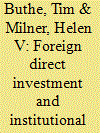

|
|
|
|
|
| Publication |
2014.
|
| Summary/Abstract |
International trade agreements lead to more foreign direct investment (FDI) in developing countries. This article examines the causal mechanisms underpinning this trade-investment linkage by asking whether institutional features of preferential trade agreements (PTAs), which allow governments to make more credible commitments to protect foreign investments, indeed result in greater FDI. The authors explore three institutional differences. First, they examine whether PTAs that have entered into force lead to greater FDI than PTAs that have merely been negotiated and signed, since only the former constitute a binding commitment under international law. Second, they ask whether trade agreements that have investment clauses lead to greater FDI. Third, they consider whether PTAs with dispute-settlement mechanisms lead to greater FDI. Analyses of FDI flows into 122 developing countries from 1971 to 2007 show that trade agreements that include stronger mechanisms for credible commitment induce more FDI. Institutional diversity in international agreements matters.
|
|
|
|
|
|
|
|
|
|
|
|
|
|
|
|
| 15 |
ID:
130538
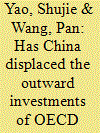

|
|
|
|
|
| Publication |
2014.
|
| Summary/Abstract |
As China has rapidly emerged as one of the world's largest investors abroad, there has been a hectic debate in the literature on whether its emergence as a major foreign investor may have undermined the importance of western industrialised economies, including those in the Organisation for Economic Cooperation and Development (OECD). This paper aims to investigate whether this is the case. The study uses a panel dataset covering 155 countries, including 33 in the OECD, where China had invested during 2003-09. This is by far the most comprehensive dataset of China's outward foreign direct investment (OFDI). A two-stage least squared (TSLS) regression approach is adopted for our econometric models according to an established augmented gravity model in the literature. The empirical results show clear evidence that China's OFDI displaces that of the OECD countries, but the argument that China's emergence is a 'new colonialism' is not supported as OECD countries' OFDI in resource abundant host countries, particularly that in Africa and Latin America, does not appear to have been displaced by China's OFDI.
|
|
|
|
|
|
|
|
|
|
|
|
|
|
|
|
| 16 |
ID:
132695
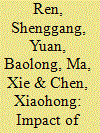

|
|
|
|
|
| Publication |
2014.
|
| Summary/Abstract |
This paper employs the input-output (IO) approach to analyze the scale and structure of embodied carbon emissions of China×s 19 industry sectors during 2001-2011 and constructs a regression model to establish the relationship between energy intensity, per capita output, trade openness, foreign direct investment (FDI), trade comparative advantage, environmental regulation, technology, and CO2 emission intensity. Our results suggest that: China×s international embodied carbon emission balance has been in a state of continuous growth for the period 2001-2011, and China has become a pollution haven; the relationship between per capita output and CO2 emission is inverse N-typed and China×s industries are in the rising stage of the curve; FDI and trade comparative advantage are two main elements boosting China×s carbon emissions; trade openness, environmental regulation, and technology will lower the growth rate of China×s industrial carbon emissions (ICEs). Consequently, China×s policies should center on adjusting the industry structure and scale of FDI inflows, transforming industries with trade comparative advantages into a clean type, facilitating environmental regulation level, and bringing in and developing low-carbon technology to avert China from being a pollution haven.
|
|
|
|
|
|
|
|
|
|
|
|
|
|
|
|
| 17 |
ID:
132265
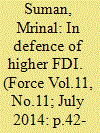

|
|
|
|
|
| Publication |
2014.
|
| Summary/Abstract |
The Indian policy regime is infamous for subordinating national concerns to the interests of some self-seeking pressure groups. Worse, a number of self-proclaimed experts readily join hands with egocentric lobbies to spread disinformation. Invariably, truth becomes the first casualty. False examples, taken out of context, are cited in support of their flawed contentions. The case of Foreign Direct Investment (FDI) in defence is symptomatic of the detrimental malaise that afflicts the Indian polity and the intelligentsia.
|
|
|
|
|
|
|
|
|
|
|
|
|
|
|
|
| 18 |
ID:
128190
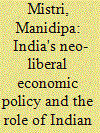

|
|
|
|
|
| Publication |
2014.
|
| Summary/Abstract |
Like other developing countries, India also faced a huge economic crisis during 90s. Basically, over the 80s there was a large and growing fiscal imbalance going on in the Indian economy and from mid 80s, India started facing problems related to balance of payments. Because of the Gulf war, India's export business decreased, oil import bill increased, credit dried up and investors were apprehensive about more investment. All these factors together led to a serious economic crisis during the end of 1990 and the government was close to default, foreign exchange reserves had been reduced and as a result, India had to airlift its gold reserves as a pledge in order to secure desperately needed international financing from international monetary fund (IMF). And, in this context, in order to secure its economy from financial crisis and to attract huge foreign direct investment (FDI), India had taken significant policy shifts in the beginning of the 90s. This new model of economic reforms is known as the neo liberal economic policy of India or LPG (liberalization, privatization and Globalization) model. The main objective of this model was to make the Indian economy as the fastest developing economy in the world which will be able to match up with the biggest economics of the world. Soon after, the government started introducing some new polices which include foreign technology agreements, foreign investment, deregulation, privatization, industrial licensing and abolition of license raj and, following the new liberal polices of India from Indian origin from different parts of the globe and overseas Indians stretched their hands with full of help to overcome this financial crisis in a number of ways. Starting from help in privatization, industrialization and foreign direct investment they have always supported their traditional homeland.
|
|
|
|
|
|
|
|
|
|
|
|
|
|
|
|
| 19 |
ID:
132517
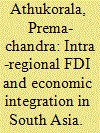

|
|
|
|
|
| Publication |
2014.
|
| Summary/Abstract |
This article examines trends and patterns of intra-regional foreign direct investment (FDI) in South Asia, with a focus on the potential for integrating production processes among countries in the region through further trade and investment policy reforms. The empirical evidence pieced together from scattered sources suggests that horizontal (market seeking) FDI has continued to dominate South Asian intra-regional FDI, with a significant shift in recent years in favour of services sector activities. Vertical (efficiency seeking) FDI in the region has remained confined to a few product lines, predominately garments, and also a few industries in which the availability of specific natural resources plays an important role in the site selection decisions of firms. In other industries, including electronics and electrical goods in which global production sharing is heavily concentrated, there is no evidence of notable cross-border operations by regional firms.
|
|
|
|
|
|
|
|
|
|
|
|
|
|
|
|
| 20 |
ID:
128264
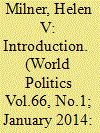

|
|
|
|
|
| Publication |
2014.
|
| Summary/Abstract |
The world economy has maintained or enhanced its integration in the past decade even in the face of the global financial crisis. A large part of this globalization has been driven by capital flows. This symposium focuses on one element of these capital flows, foreign direct investment (FDI), and on the regime in place to safeguard and promote such investments around the globe. The articles by Allee and Peinhardt and Simmons focus on the nature and evolution of the bilateral investment treaties (BITs) that have been developed to protect such investments and that have proliferated since the 1990s. The final article, by Büthe and Milner, turns its attention to the ways in which international trade agreements affect FDI. The comparison between the investment and trade agreements is instructive, since they seem to have different effects.
FDI has become one of the most important economic flows in the global economy. It is a critical source of capital for developing countries and remains a significant source of investment in the developed world. FDI has grown in part because countries changed their policies toward it dramatically after the 1980s; governments in developing countries made unilateral policy changes that opened up markets across the globe and increased competition among countries for FDI.
|
|
|
|
|
|
|
|
|
|
|
|
|
|
|
|
|
|
|
|
|